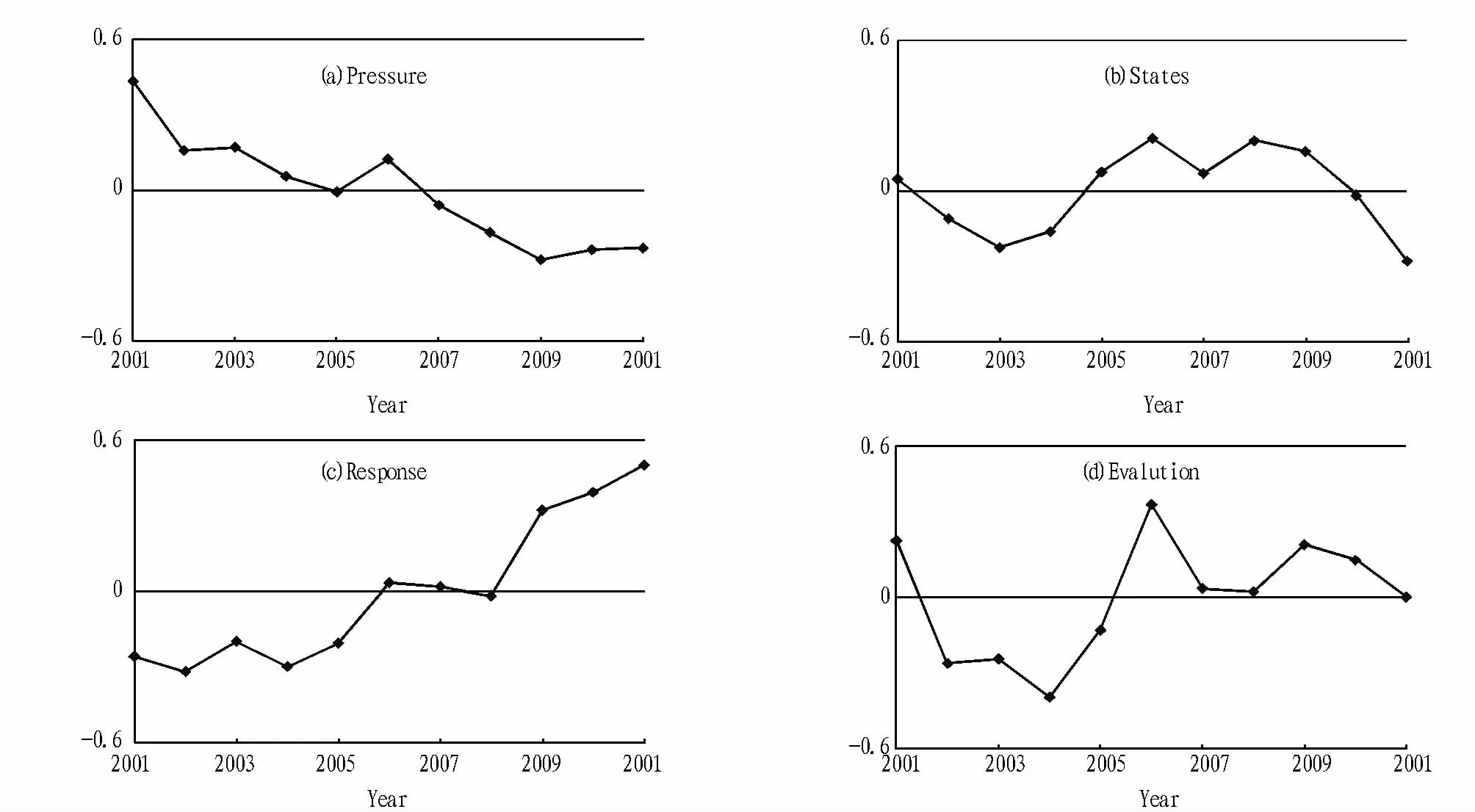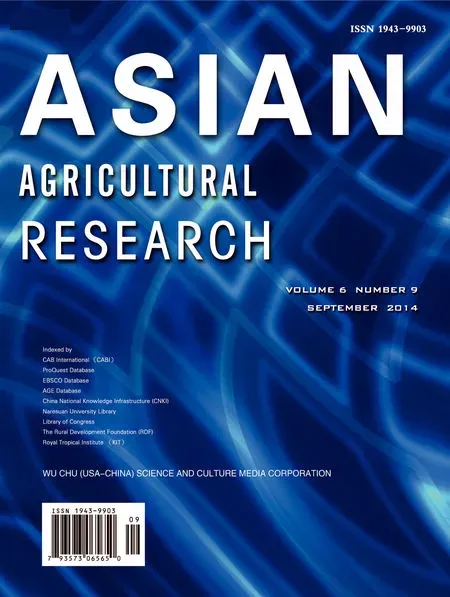Evaluation of the Agricultural Non-point Source Pollution in Chongqing Based on PSR Model
2014-04-10HanwenZHANGXinliMOUHuiXIEHongLUXingyunYAN
Hanwen ZHANG ,Xinli MOU*,Hui XIE,Hong LU,Xingyun YAN
1.Key Laboratory of Water Environment Evolution and Pollution Control in Three Gorges Reservoir,Chongqing Three Georges University,Chongqing 404100,China;2.School of Finance and Economics,Chongqing Three Georges University,Chongqing 404020,China
1 Introduction
Ecological security is one of the current forefront subjects of sustainable research,reflecting the relationship between economic activities of human society and the natural ecological environment has become a significant part of national security.In China,concept of national eco-environment security was formally proposed in 2000 by the State Council which issued the"Outline of National Eco-environment",considering it as environmental protection objective for the first time in the context of national security[1].Since the 21th century,a series of incidents on agricultural or food contamination have occurred,and each country has to increase the investment in agricultural science research,agro-technology promotion and agricultural environmental construction,and agricultural ecological security has become a pressing concern around the world.In recent years,domestic and foreign scholars have done a lot of exploration of choices in the agricultural ecological security evaluation objects,index system and evaluation method.The"Pressure-States-Response"(PSR)evaluation system proposed by the International Organization for Economic Cooperation and Development(OECD)is the foreign exploration result[2].Pressure-State-Response model is built on the interaction and impacts between human and environmental systems.It also organizes and classifies the environmental indicators with strong systemicness.PSR model takes advantage of way of thinking of"Pressure-State-Response",and rationally analyzes the interaction between human activities and the natural environment,taking the pressure(P)caused by human activities on the environment and natural resources into account,in which the state(S)of the environment and natural resources quality is changed under the pressure,when the status of the environment and resources exceed the maximum pressure range,resulting in unfavorable conditions for human survival and development.The community makes the corresponding response(R)through a series of environmental,economic and policy management practices and legal systems.In this paper,we aim to build a suitable agricultural non-point source pollution evaluation index system of Chongqing by analyzing its agricultural non-point source pollution.
2 Overview of agricultural non-point source pollution in Chongqing
Since Chongqing became a municipality for over a decade,with the rapid development of agriculture,agricultural production has also been greatly developed,and the living quality of peasants has been greatly improved.However,due to the high consumption of municipal solid waste with modern lifestyles nowadays,environmental issues have been taken as a major test,in which agricultural non-point source pollution has now become one of the key factors that restrict agricultural development.Agricultural non-point source pollution mainly refers to soil erosion and pollution caused by fertilizer,pesticides,and other livestock in agricultural production having become the main source of water pollution in the recent years,seriously threatening human survival and development[3].Currently,agricultural non-point source pollution has become one of the main threats to water quality in Chongqing.How to effectively control agricultural non-point source pollution has become a difficult problem that affects the sustainable development of agriculture.Nowadays,arable land in Chongqing has decreased,yet the total amount of chemical fertilizer and relative chemical fertilizer per unit area has increased,thereby increasing the pollution[4].
3 Chongqing agricultural non-point source pollution model PSR framework
The agricultural ecological environment problems are mainly shown in soil erosion,deterioration of water environment,increase of land pollution,biodiversity destruction and so on.Agricultural ecological environment deterioration is related to congenital fragile ecological environment,especially caused by human beings'pursuit of economic development.PSR framework model including economy,society and environment,not only means that the development society,economy and human behavior affect the environment,but also shows that the human behavior and the resulting state of the environment have an impact on the society.The feedback from society is caused by responding to environmental state changes resulting response measures[5].In this paper,based on PSR model,combined with specific issues in agricultural nonpoint source pollution in Chongqing,we conduct a series of inquiries to construct suitable Chongqing agricultural non-point source pollution evaluation system.Based on PSR framework model,agricultural non-point source environmental conditions in Chongqing,level of economic development and other factors,according to the evaluation of the relationship between objects in each group,we construct multi-level evaluation index system,and further construct the agricultural non-point source pollution evaluation system summarized as hierarchy system.
(i)The target layer:With agricultural non-point source pollution in Chongqing as a comprehensive indicator overall,it reflects the process and level of ecological safety.
(ii)Criteria layer:Formed by the target layer indicators,it indicates main factors of agro-environmental system security constraints,including pressure,state and response.
(iii)Index layer:It is a method directly reflecting the amount of the individual data or probabilities,such as chemical fertilizers usage,organic fertilizer usage levels and so on,and is also a measure of limited nitrogen and total phosphorus indicators,various environmental state and water quality standards of agricultural non-point source pollution,and it is the most basic measure of agricultural non-point source pollution system.
Data mainly come from Chongqing Statistical Yearbook 2012,Chongqing City of Water Resources Bulletin(2001-2012),and the Chongqing Municipal Environmental Statistics Bulletin(2001-2012).
C11for the amount of chemical fertilizer(kg/m2),refers to chemical fertilizer and pesticide application rate in a unit area,and is a reflection of soil nitrogen,phosphorus,and drug content;C12for the amount of pesticides(kg/hm2),displays pesticide use in per unit area,and plays a role in the study of crops or soil pesticides proportion;C13for the amount of agricultural film(kg/m2),is the ratio of per unit area covered with agricultural film with the amount of the per unit area;C14for agricultural population(million),refers to the population who live in rural areas engaged in agricultural production,with agriculture as their main source of income;C15for food production(t),refers to the entire grain harvest;C16as meat production(kg),refers to the entire meat production;C17as egg production(kg),refers to all of the egg production;C21as water COD(mg/L),and COD is chemical oxidizing agent consuming oxidant to convert the oxygen.It is the ratio of the total COD with water.Rural sewage COD =(rural/urban population)×domestic sewage COD;C22for the amount of soil erosion(kg),is the total amount of soil erosion;C23annual total precipitation(mm),represents the sum of all precipitation in a year;C24the forest coverage rate(%),refers to the total amount of forest cover per unit area;C25as surface runoff(one hundred million cubic meters),refers to the total amount of surface runoff generated;C26as water TN,TP(mg/L),total nitrogen(TN),total phosphorus(TP),is a measure of water quality.TN refers to the amount of various forms inorganic and organic nitrogen in water,TP refers to the various forms of phosphorus in water;C27is the surface water quality,and is a significant indicator of prevention of water pollution,protection of surface water quality,protection of human health and well-maintained ecosystems;C31rural Engel coefficient(%),means food consumption expenditure as a proportion of the total population of household income;C32biogas utilization(%),means biogas utilization of per unit area;C33crop straw utilization(%),is the harvest of crops recycling and incineration landfill;C34for farmers income(million),is farmer's total income obtained from various sources;C35organic fertilizer utilization rate(%),is the natural decomposition of organic matter by microbial fermentation of a class or fertilizer use in agricultural production ratio.
After the hierarchical structure model is built,we complete the construction expertise to judge scoring matrix,and then sort through the level and consistency of a single test,the total level of sorting and consistency test[6],to obtain evaluation index system,as shown in Table 1.

Table 1 Agricultural non-point source pollution evaluation system in Chongqing

(Table1)
The indicators of 2001-2011 data performed using SPSS Z normalized results are obtained and adjusted according to actual situation of positive and negative signs,and we get results of pressure,state,response,and comprehensive evaluation,respectively shown in Fig.1.

Fig.1 Agricultural non-point source pollution pressure-state-response system evaluation results in Chongqing
Fig.1(a)shows that on the whole agricultural non-point source pollution pressure tends to increase linearly,and with the development of agriculture,agricultural non-point source pollution pressures have increased,and such trends make agricultural nonpoint source pollution become increasingly serious.Fig.1(b)shows the state of agricultural non-point source pollution in the period 2005 to 2011.It was negative in 2005-2010 and there was a positive change in the 2010-2011.Agricultural non-point source pollution experienced a negative increase overall from 2001 to 2011.We can see that the state of agricultural non-point source pollution is volatile.Fig.1(c)shows that the response to overall agricultural non-point source pollution is gradually changed from negative to positive,showing a positive linear increase in the state.With the development of agricultural science and technology,agricultural non-point source pollution responds in the right direction,and the agricultural non-point source pollution in response to the overall linear trend for agricultural non-point source pollution impact is smaller.Fig.1(d)shows that in 2001-2004,there was a change from positive to negative values for agricultural non-point source pollution effects,and comprehensive value decreased,mainly due to the reason that agricultural non-point source pollution response at this stage was relatively low.During 2009-2011,agricultural non-point source pollution response was relatively high,but due to the increaseing impact of agricultural non-point source pollution pressures,at this stage the impact of agricultural non-point source pollution also showed good condition.The trend in volatility has certain similarities,primarily because there are changes in agricultural non-point source pollution pressures and agricultural non-point source pollution response offsets what each has contributed to.
4 Conclusions
Based on the Chongqing market source pollution PSR model framework,combined with the status quo of Chongqing agricultural non-point source pollution,PSR model is used to construct index system,and then each index is standardized using SPSS,to analyze the agricultural non-point source pollution pressures,state and response,in order to comprehensively assess the agricultural non-point source pollution.And according to the chart on agricultural non-point source pollution,we analyze the agricultural non-point source pollution pressures and responses,and the results indicate that the overall trend shows linear increase and decrease and the agricultural non-point source pollution is in a state of fluctuation.Through the further analysis and evaluation,it aims to provide a reference for the future quantitative analysis of agricultural ecological security in Chongqing.
[1]YU F,WANG XF,XU HL,et al.The research on agroecological security progress in China[J].Journal of Taiyuan Normal University(Natural Science Edition),2008,7(4),110-113.(in Chinese).
[2]LIZC,LIU LD,SUN YF,etal.Assessment method of regional ecological security based on Pressure-State-Response model[J].Acta Ecologica Sinica,2010,30(23):6495—6503.(in Chinese).
[3]LIU JH,LAIGY.Research progress of the agricultural non-point source pollution[J].Journal of Water Resources&Water Engineering,2007,18(1)29—32.(in Chinese).
[4]WANG XL.Status of agricultural nonpoint source pollution and prevention research in Chongqing[J].Studies of Trace Elements and Health,2007,24(3),35-37.(in Chinese).
[5]WANG HY,ZHAIRC,CAIDL.Evaluation index system construction of cultivated land resource sustainable use on PSR model[J].Heilongjiang Agricultural Sciences,2010(2):33-35.(in Chinese).
[6]ZHANG SY,XUAN GL.Integrating AHP into the M&A strategy[J].Journal of China Textile University(English Edition),2000(1):88-91.
杂志排行
Asian Agricultural Research的其它文章
- Farmers'Willingness to Pay(WTP)for Reducing Agricultural Non-point Source Pollution:Based on the Empirical Analysis of 453 Farmers
- A Study of the Artificial Vegetation Restoration Technology in the Wenchuan Earthquake Area
- Evaluation of the Development of Circular Agriculture in Chongqing City Based on Entropy Method
- Evaluation of the Overall Level of New Urbanization in Hebei Province Based on Factor Analysis and GIS
- Empirical Analysis of the Typical Breeding Pattern of Clam in Hongdao Town and the Preliminary Estimates of Costs and Benefits
- Theory and Practice of Marine Regional Management in China
